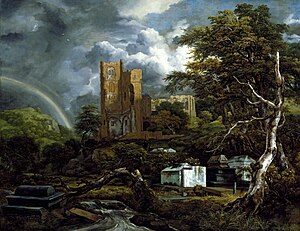
Back المقبره اليهوديه ARZ El cementerio judío, (Ruysdael, Detroit Institute of Arts) Spanish Le Cimetière juif French De Joodse begraafplaats Dutch Judovsko pokopališče Slovenian
| The Jewish Cemetery | |
|---|---|
| NL: Het Joodse kerkhof, NL: De Joodse begraafplaats | |
 | |
| Artist | Jacob van Ruisdael |
| Year | 1654 or 1655 |
| Medium | Oil on canvas |
| Dimensions | 142.2 cm × 189.2 cm (56.0 in × 74.5 in) |
| Location | Detroit Institute of Arts, Detroit, MI 48202 |
| Accession | 26.3 |

The Jewish Cemetery is an oil-on-canvas painting by the Dutch landscape painter Jacob van Ruisdael, now at the Detroit Institute of Arts.[1]
The Jewish Cemetery is an allegorical landscape painting suggesting ideas of hope and death,[2] while also depicting Beth Haim, a cemetery located on Amsterdam's southern outskirts, at the town of Ouderkerk aan de Amstel. Beth Haim is a resting place for some prominent figures among Amsterdam's large Jewish Portuguese community in the 17th century.[3] The tomb monuments commemorate leaders of the newly arrived Portuguese-Jewish population.[1] The central elements of the painting differ from what one would see in Ouderkerk, as Ruisdael made adjustments to achieve compositional and allegorical intent.[2] The picture's physical dimensions are twice that of typical landscape painting from the 17th century.[3] After being cataloged in England in 1835, the work disappeared from public display for many years,[4] before emerging at through various auctions in London and Berlin.[2][5] The Detroit Institute of Arts acquired the painting in 1926 from Julius H. Haass, given in memory of his brother.[6]
Jacob van Ruisdael created two versions of The Jewish Cemetery in 1653 and 1655 while in his mid-twenties, according to Erich Simon.[7]
- ^ a b Scheyer, Ernst (1977). "The Iconography of Jacob van Ruisdael's 'Cemetery'". Bulletin of the Detroit Institute of Arts. 55 (3): 133–146. ISSN 0011-9636.
- ^ a b c Nadler, Steven (2003). Rembrandt's Jews. University of Chicago Press. ISBN 978-0-226-56737-2.
- ^ a b Kutasz Christensen, Theresa A. (January 11, 2021). "Jacob van Ruisdael, The Jewish Cemetery". Smarthistory. Retrieved 19 April 2023.
- ^ Rosenau, Helen (1958). "The Dates of Jacob van Ruisdael's 'Jewish Cemeteries'". Oud Holland. 73: 241–242. ISSN 0030-672X – via Brill.
- ^ Rosenberg, Jacob (February 1926). ""The Jewish Cemetery" by Jacob van Ruisdael". Art in America and Elsewhere. 14 (2): 37–44.
- ^ Valentiner, William Reinhold (February 1926). "The Cemetery by Jacob van Ruysdael" (PDF). Bulletin of the Detroit Institute of Arts. 7 (5): 55 – via DALNET.
- ^ Simon, Kurt Erich (1930). Jacob van Ruisdael: eine Darstellung seiner Entwicklung (in German). Berlin Lankwitz: Würfel Verlag. p. 31.